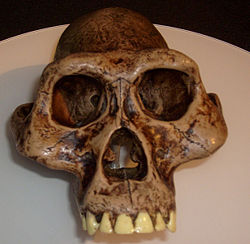Australopithecus afarensis
| Australopithecus afarensis |
|---|

|
| Scientific Classification |
|
| Binomial Name |
|
Australopithecus afarensis |

|
| Skull reconstruction |
Australopithecus africanus is a species of australopithecines that are believed to be man's earliest ancestors, but which are commonly viewed by creationists as being merely apes.
Lucy
An Australopithecine named Lucy was discovered by Donald Johanson in 1973, near Hadar in Ethiopia. The name Lucy was derived from the Beatles song "Lucy in the Sky with Diamonds", which was playing in the camp the night after the fossil was discovered. Johanson also called the collective fossils from the area the "First Family", helping to popularize the find as early humans.
Initially only a knee-joint was found, which he believed was 3 million years old, based on the animal fossils in the area. A 40%-complete skeleton of a 3.5 ft tall female was later discovered in another location sixty to seventy meters higher in the strata and two to three kilometers away.
The claim that Lucy walked upright was largely based on the appearance of the leg and hip bone. However, like all australopithecines, Lucy has long forearms and short hind legs. Australopithecines also have curved finger and long curved toes. Curved fingers and toes in extant primates are readily recognized as having no other purpose other than full or part time arboreal (tree-dwelling) life.
Kevin Anderson cites an interview aired in a Nova Episode in which Dr. Own Lovejoy reported that the anatomy of Lucy's hipbone was more like primate than human anatomy. He presumed that this was because the pelvic bone was damaged and reshaped a cast of the bone to give it a more human shape. Anderson points out the circularity of using assumptions of human evolution for the reconstruction and then using it as evidence for evolution.[1]
It should also be noted that bipedal walking is common among living Gorillas and some Chimpanzees. However, this mode is not truly bipedal, and is more accurately referred to as knuckle-walkers. Living nonhuman primates and australopithecines are probably analogous in this regard and neither can therefore be considered any closer to humans than the other.
Another challenge to Lucy was discovered in the Tugen Hills of Kenya in the year 2000. The specimen was alleged to show capability for walking upright -- and was dated 3 million years earlier than Lucy.[2]
Quotes
Charles Oxnard, former director of graduate studies and professor of anatomy at the University of Southern California Medical School, who subjected australopithecine fossils to extensive computer analysis stated: "The australopithecines known over the last several decades from Olduvai and Sterkfontein, Kromdraai and Makapansgat, are now irrevocably removed from a place in a group any closer to humans than to African apes and certainly from any place in a direct human lineage. All this should make us wonder about the unusual presentation of human evolution in introductory textbooks, in encyclopedias and in popular publications. In such volumes not only are australopithecines described as being of known bodily size and shape, but as possessing such abilities as bipedality and tool-using and -making and such developments as the use of fire and specific social structures. Even facial features are happily (and non-scietifically) reconstructed.". (The Order of Man: A Biomathematical Anatomy of the Primates, p332.)
References
- ↑ What Is New Is Old Again. Editorial by Kevin Anderson. CRSQ 45(4):pp241-242. Spring 2009.
- ↑ Chimp-sized hominid walked upright on two legs six million years ago by Barbara Hale, Penn State University. Eurek Alert, September 2, 2004.
News
- Australopithecus Was a Well-Adapted Tree Climber New research has confirmed that an extinct type of ape called Australopithecus afarensis was a well-adapted tree climber. ICR Daily Science Updates, November 12, 2012.
External links
Creationist
Articles
- 'Ape-woman' statue misleads public: anatomy professor Creation 19(1):52. December 1996
- Did Lucy walk upright? by Michael Oard. Journal of Creation 15(2):9–10. August 2001
- Farewell to “Lucy” by Dr. David Menton, AiG-USApril 18, 2007
- The ‘Lucy Child’ by Carl Wieland. Creation Ministries International. Journal of Creation. 20(3) 2006
- ‘Lucy’ isn’t the ‘Missing Link’! Creation 12(3):32. June 1990
- Lucy: walking tall—or wandering in circles? by Carl Wieland, CMI–Australia. 22 July 2005
- New evidence: Lucy was a knuckle-walker by David Catchpoole. Creation Ministries International. May 2000
- Lucy Was Buried First by Kurt Wise. Answers, February 2008
- New hominin skull from Kenya by Marvin L. Lubenow. Journal of Creation 15(2) 2001.
- No more love for Lucy? by Daniel Anderson. Creation Ministries International, May 4, 2007.
- No more love for Lucy? by Daniel Anderson. Journal of Creation 21(3) 2007
- They Love Lucy Answers, April 17, 2007.
- Was Lucy bipedal? by Marvin Lubenow. Journal of Creation 19(3):13. December 2005
Videos
- Lucy—She's No Lady! seminar by David Menton. Available as a free download
Books
- Tornado in a Junkyard by James Perloff
Secular
- Lucy's Knee Joint: A Case Study in Creationists' Willingness to Admit their Errors by Jim Lippard. Talk.Origins Archive
- Lucy on the Ground with Knuckles ScienceNews Vol.157 #15 p. 235, April 8th, 2000.
| |||||||||||||||||


